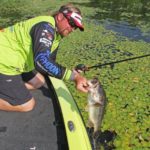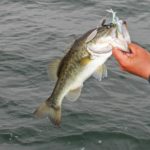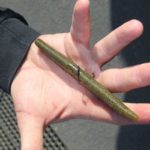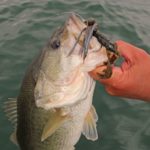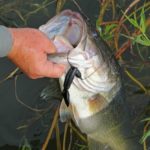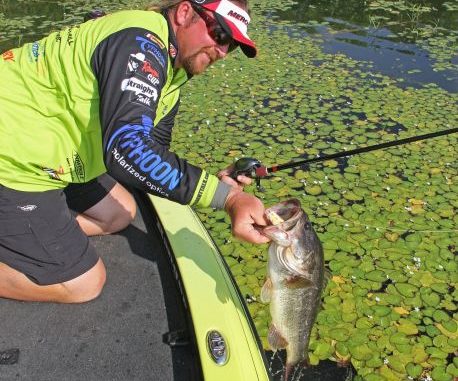
When bass don’t feel like moving, make it easy for them by slowing down.
When largemouth bass play hard to get, it’s time to pull out the clichéd yet profoundly applicable allusion of the tortoise and the hare.
No doubt, when extreme heat, extreme cold or a high level of fishing pressure has the fish turning their backs to reaction baits, your most productive strategy is go slow and steady.
Winter is the natural thought here, as lower metabolism keeps the fish in slow mode for several months. However, summer months also need a slow-down, as lower dissolved oxygen in the water puts fish in a sluggish mood.
During summer’s sweltering temperatures, bass simply don’t chase their prey as much. Not that they can’t; they just don’t want to, so the bottom line is declined aggression.
So, notwithstanding the brief flurries of activity you’ll often find at dawn and dusk, plan on slowing down in most bass habitat you fish during the day.
Toledo Bend guide Stephen Johnston said laydowns — especially those in rivers and streams lacking aquatic vegetation — are prime targets for slow presentations. This cover offers the shade that bass need on hot days, but the fish will be profoundly inactive without vegetation expelling oxygen.
Conversely, Johnston finds hydrilla beds abounding with summertime potential. The dense, tangled mass of aquatic weeds cleans and invigorates the water, thereby promoting a bass-friendly scenario.
“Hydrilla filters the water and pumps more oxygen into the water,” Johnston said. “It kind of acts like a pine tree. If you’re in a lake and you can choose to fish one side with no hydrilla or one side with vegetation, you want to make sure you fish that side with the vegetation because those fish will be more active than the ones on the side with no vegetation.”
Slow Pokes
For starters, “slow” is not necessarily synonymous with a heavy object pegged to the bottom. No doubt, creeping that 10-inch Texas-rigged worm across wood and rock will produce bites, but so will a tiny worm, lizard or creature bait on these rigs:
• Dropshot – Adjust your leader length to hold the bait at the right depth, relative to cover and/or fish positioning.
• Shaky head – A great choice for probing docks, bridges and rocks, this specialized jighead works best with slender worms that stand up and wiggle with minimal rod work. Extremely limber hand-poured worms really dance enticingly.
• Wacky worms – With a hook impaled through the worm’s midsection (or under an O ring), both ends of the bait wiggle like the real thing as the rig slowly falls through the water. This is a great way to coax bites along the outer edge of a lily pad field. In deeper areas, add a peg weight or replace the standard hook with a weighted flick-shake hook.
One of Johnston’s favorite slow-down rigs is a 4-inch V&M Chop Stick Texas rigged with a 1/16-ounce weight. Light Texas rigs like this probably won’t cut it in 20-plus feet, where current and line drift will often pull your bait off target.
However, for shallow flipping or dragging, such diminutive packages look like the kind of meals bass are likely to favor on these low-speed days.
“You don’t have to have a big, bulky bait,” Johnston said. “During those hot days, the fish look at that smaller bait as easier prey to get than, say, a big beaver-style bait or a crawfish-style bait.”
One of the more-innovative tactics to come out of California’s finesse-heavy bass scene is the scaled-down Carolina rig. A tactic fit for any situation requiring small lures and slow-moving presentations, the Little C allows you to present a light rig without the bold, intrusive principle of a traditional setup.
In his Northern California home waters of Shasta Lake, Jason Milligan has perfected a rig that serves bass anglers in just such tough scenarios.
Milligan’s specialized C-rig starts with 8-pound Seaguar fluorocarbon as main line sans the leader, thanks to a stiff rubber stopper called a Carolina Keeper that eliminates a swivel and one knot in the light line. Positioned below a 1/8- to 1/4-ounce tungsten bullet weight, the adjustable stopper slides along the line for instant leader adjustment.
Milligan sets his leader at 1 1/2 to 4 feet long, and omits the rattle beads to avoid spooking sluggish fish.
To create the right presentation, Milligan uses a Damiki Air-Pocket worm on a light 1/0 to 2/0 Roboworm rebarb hook. The combination of minimal hook weight and bait buoyancy allows the worm to float as high as his leader length, enabling Milligan to simulate the look of a dropshot bait, only with a more active appearance.
“The way I set up (my rig) with a light wire hook, it allows the bait to float up off the bottom and target those fish that are in reach of where you’d normally catch them on a dropshot — even if they won’t react to a dropshot,” Milligan said.
Hold your ground
JT Kenney, an FLW touring pro from Florida, is no stranger to power fishing, but he said there are times when he comes across a nice piece of shoreline cover that needs a thorough picking.
In such cases, he’ll drop his twin PowerPoles to hold the angle and distance he needs from the cover, and then he persistently works the spot — often with a variety of baits until he makes something happen.
In water too deep to stake out, savvy anglers have learned to use the PowerPoles to reach across dock cables and overhanging limbs to hold their ground for slow fishing.
At the other end of your line, you can effect a slow presentation by minimizing your bait’s forward progress and maximizing its face time in a particular area. Stroking a jig, vertically hopping a tube, suspending jerkbaits — all keep the potential meal in front of bass long enough for the fish to saunter over and bite.
Topwater frogs are another good example of this principle. More commonly worked with twitching, chugging or walking presentations, these baits can tempt some of the most-exciting surface strikes imaginable.
However, bass that don’t feel like chasing down an ambling amphibian may just let it go by. The solution? Let that frog pause and kinda wiggle back and forth in an area the size of a dinner plate, and you’ll often tempt something big into tip-toeing upstairs to slurp down this easy target.
Bassmaster Elite pro and frog expert Ish Monroe said the key to this deal is working the frog on a slack line, so it kind of walks in place. Working this slow, nearly stationary presentation along the edge of a grass line or next to a dock will often deliver the desired results.
Also, try this over one of those random “windows” in a weed mat or a lily pad field, as these natural access points are where lethargic bass are more likely to gobble the amphibian imposter.
Below the surface, letting that jig or Texas-rigged bait soak a little longer than usual can often help pick up another bite during a slow period.
When flipping beavers or big worms or punching hefty baits, for instance, Johnston notes that persistent pestering affects bass very much like it affects humans.
“If you’re sitting in your living room, watching TV and someone starts dropping french fries in front of your face, you might ignore them at first, but after a while you’re going to grab one of those french fries,” he said. “With bass, when they’re sitting there comfortably in their (fortress) beneath the vegetation and a bait drops in front of them and stays there, they won’t be able to resist it forever.”
